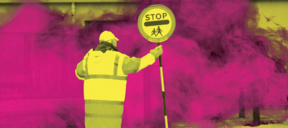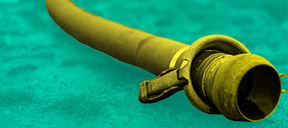Suspected false documents and illegal dumping: the murky world of poultry manure
Noteworthy reveals serious concerns over authenticity of files used in some poultry farm planning cases in the North and where the manure is going.
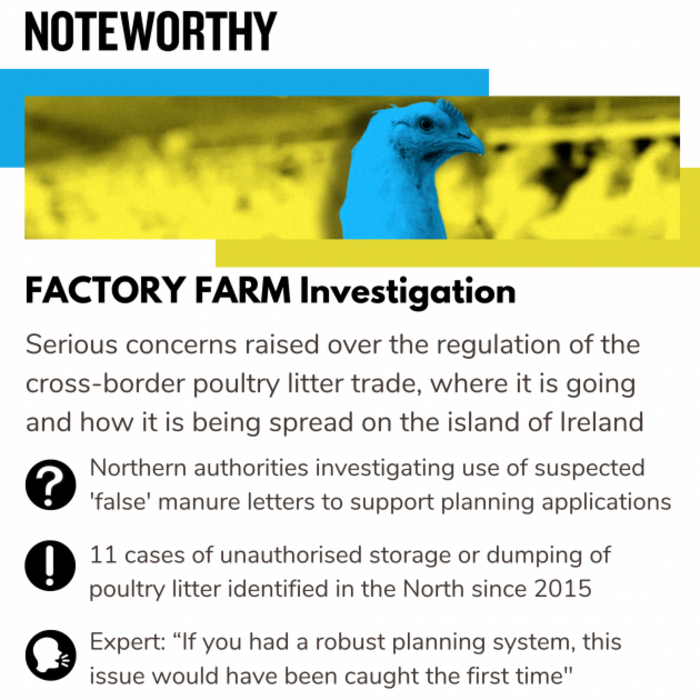
—
JUST LIKE ANY other ordinary day out on the farm gearing up for the busy 2021 spring tillage season, John* received a call about animal manure – a rich, natural fertiliser used across the island to help boost crop yield. This call was different, however – “one of those phone calls you don’t expect”.
The call came from an old college pal, now working in the agri-research body Teagasc, who told him that he came across John’s name on a contract to take litter from a farmer applying for planning permission for a poultry farm in Northern Ireland.
“Looking at the document and looking at the signature, he knew, just by the quality of the signature, it wasn’t my signature,” John told us.
This call was soon followed by a Teagasc letter in March 2021 informing him of “question marks” over the letter’s validity, as well as that of a Teagasc letter claimed to have been sent on his behalf stating his farm had capacity to import and spread litter.
These Teagasc letters and litter contacts are vital files submitted as part of planning applications for poultry farms in Northern Ireland, without which applicants face the risk of being refused permission as the industry continues to expand and searches for an outlet for the large volumes of litter produced.
“I was quite incredulous that somebody could use my name and use the land of this farm to justify getting planning permission,” John said.
John is not alone, however, and was just one of 15 farmers in the Republic of Ireland that Teagasc contacted in early 2021 about the use of their details in suspected falsified or altered records submitted as part of planning applications for poultry farms in the North.
As part of our FACTORY FARM investigation with The Detail and The Guardian, we took a deep dive into the regulation of the all-island poultry litter trade.
We analysed planning and enforcement files, spoke with environmental scientists, planning experts and environmental groups, and sent over 75 access to information requests to chart serious issues raised. Our findings reveal:
- A Teagasc investigation in 2021 – prompted by concern from a member of the public – found suspected falsified or altered letters were used to support over 20 poultry farm planning applications in Northern Ireland
- Authorities in the North are investigating the potential falsification of Teagasc documents submitted as part of a number of planning cases
- Cases of suspected falsified EPA letters on other planning files were discovered by our team, with the environmental watchdog investigating the matter
- Several farmers in the Republic told us their names were used without permission on litter contracts, totalling 7,000 tonnes per year
- 11 cases of unauthorised dumping or storage of poultry litter were discovered during farm inspections in the North since 2015
- Councils with the most poultry farms in the Republic have raised concern we lack a robust monitoring and enforcement regime to verify where litter is going
- Half of 110 poultry farms surveyed in Monaghan and Cavan in 2017 and 2018 did not return litter export documents to the Agriculture Department
In part two of this investigation we examine the direct impact of farms in the border region on protected nature areas, and concerns over wider environmental impacts of the industry. This article was developed with the support of Journalismfund.eu.
—
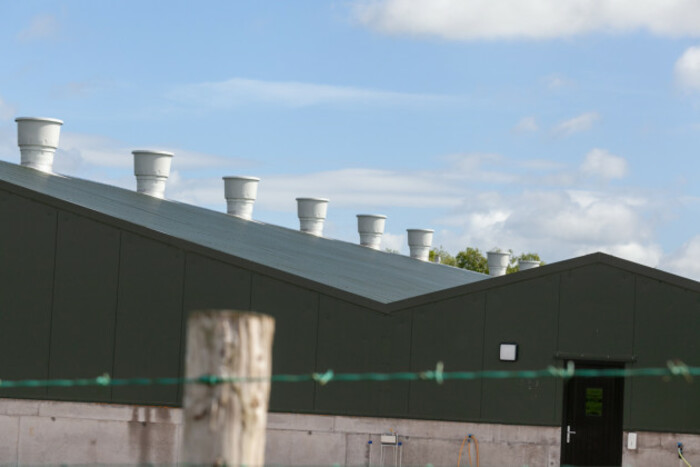 Poultry shed in the border region that has the highest concentrations of farms on the island
Poultry shed in the border region that has the highest concentrations of farms on the island
Explosion in poultry farms
A “farming and industrial success story”. This is how the Irish Farmers’ Association (IFA) described the Irish poultry industry in a letter to the Minister for Agriculture last February bringing his attention to a new report on the burgeoning economic role of the sector.
The University College Cork report - commissioned by the IFA’s Poultry Working Group – said that the industry today supports over 5,000 jobs – 3,500 in the border region – with a value of €611 million.
This is not surprising as poultry is our most consumed meat, with over 110 million birds processed for meat and 900 million eggs produced annually. According to the latest Census of Agriculture – we had close to 16.5 million poultry in 2020 – a 50% increase in just a decade.
According to the Central Statistics Office, the poultry population “has never been as large” as it is today, with almost three-quarters of the birds concentrated in the border region in Monaghan and Cavan.
The situation is the same just across the border, with significant expansion over the past decade in Northern Ireland largely driven by State policy. The poultry giant Moy Park, for example, outlined ambitious expansion plans in the early 2010s and, by 2015, it alone was processing five million chickens per week – up 60% from just six years earlier.
Moy Park said that it is a “responsible business” and that all expansion plans are subject to “highly regulated” environmental modelling. “No decision,” it said, “is taken without the appropriate full planning permission” and relevant licensing approval.
Today, there are almost 24.5 millions birds on farms in Northern Ireland, a near doubling in two decades. The rapid growth in farms and bird numbers, however, has created a problem – the sheer volume of litter produced and the ammonia emissions that come with it.
Our ammonia problem
Poultry manure is rich in nitrogen, phosphorus and potassium and is a powerful fertiliser, used for compost in the mushroom industry and landspreading on tillage and vegetable farms to encourage crop growth.
However, there is a downside to the production of such quantities of litter that can cause environmental and human health risks, such as water, air and soil pollution, spread of antimicrobial residues, and respiratory issues.
This is because animal waste produces an air pollutant called ammonia, 99% of which is linked to agriculture, and already at dangerously high levels on our island.
Our analysis of planning documents for farms in the North show a large percentage are within a short distance of protected nature areas, many of which have high levels of ammonia, impacting on flora and fauna protected under EU law.
- In part two we examine the impact of farms on protected nature areas, and concerns over wider environmental impacts of the industry.
In order to obtain planning permission, applicants must provide evidence they can safely dispose of, or store, manure produced by their farm. Much like in the South, however, most farms do not have the capacity to store the quantity of litter produced as farms expand.
The inability to handle litter is a problem that authorities in the North have been aware of for at least a decade, with the scientific advisor in the Agriculture Department (DAERA) telling the Agriculture Committee in May 2012 that the “key issue” for the poultry sector was litter.
At the time, 260,000 tonnes were produced every year, yet farms only had the capacity to sustainably manage 100,000 tonnes. “We are therefore left to find a home or an alternative use for 160,000 tonnes of poultry litter,” he said, with export now a vital component of the industry.
Records released by the Department of Agriculture (DAFM) show that over 280,000 tonnes of poultry litter was imported from Northern Ireland since 2017, with almost 65,000 tonnes imported last year.
Official records of shipments held by DAERA – released to The Bureau of Investigative Journalism and shared with our team – show litter was sent to farms for landspreading, to a biogas plant, and to mushroom composting facilities.
In the vast majority of confirmed exports with official records in 2021, the litter was sent from farms contracted to the powerhouse Moy Park that posted after-tax profits of almost £67 million (€74m) in 2020.
In planning applications, farms linked to Moy Park need to provide confirmation that their litter will be accounted for under the processor’s litter production limits agreed with authorities in the North.
When contacted by our team, Moy Park said that it was not aware of the falsification or altering of letters as an issue in the industry or indeed with its contracted farmers. There is nothing in our investigative findings that indicates Moy Park or any of its providers are linked to any cases where falsification or altering of litter contracts have been identified.
Industry expansion hinges on waste exports
Other farms not linked to the processor must provide a litter contract with a farmer, compost facility or biogas plant in the south as part of their planning applications.
Our analysis shows that, in the majority of these cases, farms would not have received planning permission without these documents.
Planning records examined by our team show that, in many cases, the Northern Ireland Environment Agency (NIEA) was only satisfied poultry litter would be utilised in a sustainable manner when the applicant provided litter export contracts.
In other cases, Shared Environmental Services (SES) – a council-based body which provides guidance to planners – only found that farms would not have an adverse effect on protected nature sites if the applicant exported litter as outlined in the contracts.
In the majority of council decisions, planning permission was granted on the condition the applicant fully adhere to the litter disposal agreement or contract. In some cases, it is explicitly stated that it would be a breach of planning controls if litter is not exported as described.
In the case of a contract to export animal manure to a farm, DAERA, as a statutory consultee to the Northern Ireland planning regime, stipulates that the planning application must contain evidence that the recipient is a bona fide farmer with the capacity to use the stated volumes of litter without breaching their own farm nutrient limits.
Role of Teagasc letters questioned
DAERA has to date accepted Teagasc letters as appropriate evidence in this regard. Our analysis shows that official letters are almost always provided by the agri-research body, with letters included with over 80 planning applications since 2015.
The importance of these Teagasc letters in securing planning permission raised alarm with a member of the public in early 2021, with a complaint letter sent to Teagasc in which the authority’s role in sending the letters was questioned.
A concern was raised that Teagasc was, de facto, unwittingly providing consent for landspreading without any environmental assessments. The complaint included a list of 38 planning files in which, what appeared to be Teagasc letters, were provided as part of the planning application.
According to records released to our team, the then-Director of Teagasc Gerry Boyle replied in March 2021 stating Teagasc does not provide any form of consent to farmers. He said the letters only “provide a technical assessment of the capacity of the farm to utilise a particular manure… in full compliance with Irish law”.
In terms of the 38 planning files listed in the complaint, Boyle said Teagasc was examining “the provenance of each of the documents related to Teagasc”.
Records released under Freedom of Information (FOI) reveal that Teagasc’s analysis turned up a completely different issue, and a much bigger one – the suspected falsification of records to support planning applications in the North.
 New poultry shed under construction on farm in the border region
New poultry shed under construction on farm in the border region
Teagasc investigation
An internal investigation carried out in March 2021 found that 60% of the letters said to be from Teagasc were suspected to be either “falsified” (15) or “amended” (8), with only 40% (15) verified as being “legitimate”.
Interviews were held with farm advisors whose supposed signatures appear on the letters, as well as searches of emails and other records on the advisors’ computer systems.
All staff fully co-operated and Teagasc “found no evidence… staff had any involvement in the supply of falsified documentation,” a report on the investigative findings stated.
The 15 farmers listed in the letters as the supposed litter recipients were also contacted by Teagasc, with the report stating that the communication with the farmers “backs up the concerns raised by advisers in relation to the veracity of the documents in question”.
Described as “a matter of significant concern”, the Teagasc investigative report stated it was “clear” that “there exists a significant level of falsification and alteration without consent of documents in support of [Northern Irish] planning applications”.
According to a letter that Teagasc sent to DAERA in March 2021, An Garda Síochána was notified and the Northern authorities were asked to contact Teagasc “prior to placing reliance on any documentation purportedly submitted by Teagasc”.
‘Serious issues’ raised
Geraint Ellis, chair of Environmental Planning at the School of Planning in Queen’s University Belfast (QUB), said that the issues identified by Teagasc “raises all sorts of potentially very serious issues”.
Ellis, who also sits on the National Economic and Social Council, examined the Teagasc report and letters to the Northern authorities, and told our team that “it’s very clear that there’s been potentially large-scale falsification of documents”.
While he found it “really shocking” to read the documents, Ellis said that “in some ways, it didn’t surprise me”, pointing to decades old “systemic problems with environmental regulation and the planning system in the North”.
Such issues, he said, were highlighted in March by the Public Accounts Committee in Stormont that “produced one of the most damning reports ever seen in terms of planning”.
The report, he said, “comes on the back of many, many other reports over decades highlighting this problem,” including low enforcement action, lack of transparency, skills shortages and resource shortfalls in the planning system.
“It’s really in crisis and I think what you found is a very good example of this,” he said. “If you had a robust system [any potential falsification of documents] would have been caught the first time, let alone God knows how many times.”
Additional planning files identified
In its letter to DEARA, Teagasc provided details of the planning cases with suspected false or altered letters. While details were redacted in released records, our team was provided with the list of 38 cases sent with the original public complaint to Teagasc.
Our analysis shows that planning permission was granted in more than 25 cases, however, there is nothing to suggest any of these cases were on Teagasc’s list of suspected falsified or altered letters.
We asked Teagasc if it has carried out a wider search of planning records to determine if any further applications were submitted with Teagasc letters. It said that it has completed its investigation and that no further cases have been analysed.
Our team then carried out a examination of several hundred planning files and identified over 40 additional applications between 2015 and 2021 where litter contracts with farmers in the Republic and Teagasc letters were included as part of the application files.
We also provided Teagasc with the list of the additional cases we identified – some of which were still active in the planning system at the time of publication – and asked them to examine the files and contact the farmers listed as recipients.
A spokesperson for Teagasc said it has “not pursued” a wider investigation as it has already highlighted the issues identified to Northern Irish authorities and “consider that follow-up across a wider range of files is within the remit of the Planning Authorities holding these files rather than Teagasc”.
“Teagasc have responded to a number of requests from Northern Ireland Planning Authorities for clarification in relation to individual files where they have queried,” it added.
Our team also discovered that suspected falsified documents claiming to be from the Environmental Protection Agency (EPA) were also submitted in a number of separate planning applications for other Northern Irish farms.
When our team raised this with the EPA, it said that the letters contained major inconsistencies, such as not being on official paper or being signed by non-existent staff.
The EPA said it took the issue “very seriously” and carried out an internal investigation, and that any future cases should be raised with the northern planning authorities.
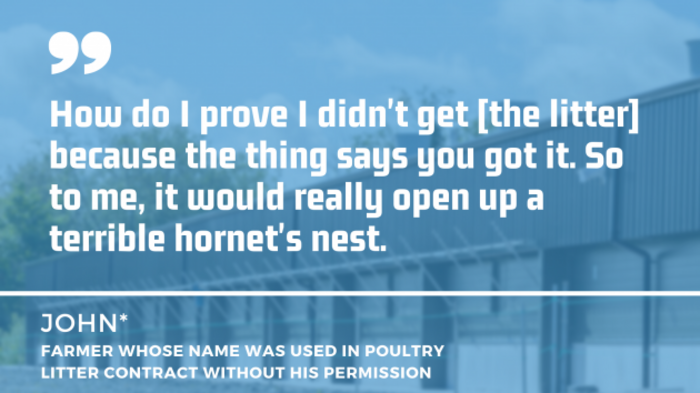
‘Open up a terrible hornet’s nest’
We attempted to contact all farmers whose names appear on the letters as the recipients of litter, providing them with a copy of the letters and asking them to confirm if they had signed them.
Fourteen farmers confirmed the contracts were legitimate, although a few said they have not received any litter. The amount of litter supposed to come to these farms is 2,000 tonnes per year.
Eight farmers – some of whose details were used on multiple applications – told our team they had no knowledge of signing any agreement to take litter. In total, the amount of poultry litter listed in these cases totals 7,000 tonnes claimed to be going to farms every year that is potentially unaccounted for.
While most farmers did not want to speak on record, John* explained to us how he was “annoyed” once he found out someone used his name, especially as it could have a serious impact on his farm subsidies if, on paper, it looked like he was exceeding his nitrogen limits by taking this poultry litter.
“From a farming point of view, keeping things on the right side of the EU is a very important thing and probably the most important part of that is the Nitrates Directive,” he told us. “It’s one that you cannot screw up on.”
If Department of Agriculture inspectors were to see his name on the litter contract and suspect he had failed to declare organic fertiliser spread on his land, John said “they’re going to fine me very substantially and I would probably lose two to three years of the single farm payment”.
“How do I prove I didn’t get it because, you know, the thing says you got it. So to me, it would really open up a terrible hornet’s nest,” he said.
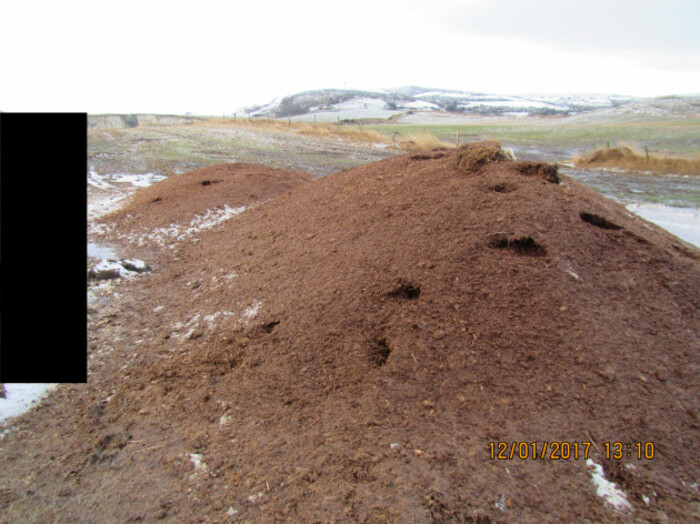 Poultry litter dumping case identified by Northern authorities in January 2017
Poultry litter dumping case identified by Northern authorities in January 2017
Where is the litter going?
Alongside his concerns over the use of potentially falsified letters, QUB’s Ellis raised concern over what happens with the litter as “there’s clearly waste that’s just not going where it should be”.
“If you start looking at that, I think the whole issue then just broadens out very quickly because if the waste isn’t going to where it should, it must be going somewhere else, and then if it’s going somewhere else, what environmental damage is that doing?”
While our team was unable to trace down where the litter may end up, through information requests to Northern authorities, we have uncovered cases of dumping or storage of poultry litter on farmland without authorisation.
DAERA released information on 11 cases between 2015 and 2017 where unauthorised poultry heaps were discovered during inspections. DAERA refused to provide any details on the farms, locations or individuals involved and only supplied photos.
Therefore, there is nothing to suggest that any of these incidents are linked to the cases identified by Teagasc or cases where farmers told our team that they never signed litter contracts.
An analysis of the photos shows there were several cases where large mounds of litter were discovered. In one case, the litter was dumped close to a stream, carrying the potential to impact the quality of the water course.
In two of the cases, the breach was found to be intentional, with off-farm effects identified in four cases. One farmer was found to have stored litter without authorisation in both 2016 and 2017.
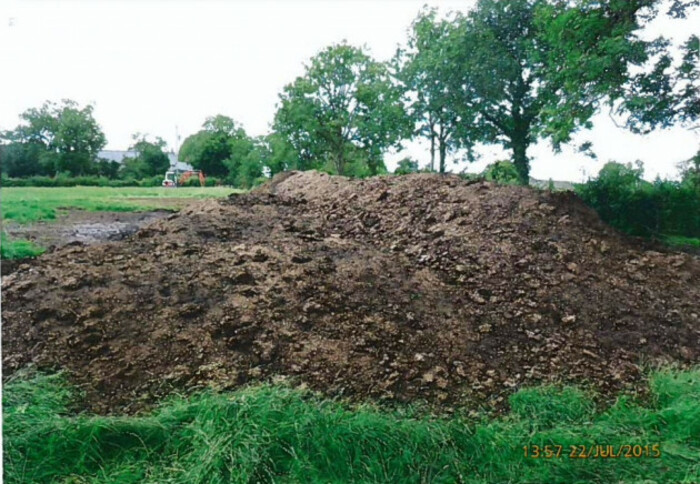 Poultry litter dumping case identified by DAERA in July 2015
Poultry litter dumping case identified by DAERA in July 2015
Northern authorities taking action
According to QUB’s Ellis, there are three things that can be done immediately by authorities in the North in relation to the use of potentially falsified or altered letters, starting with a criminal investigation examining any potential fraud element.
Then within the planning system, there are two options available, he said, most importantly, examining the individual cases flagged by Teagasc to confirm if planning conditions on litter removal are being met.
“If the waste isn’t going to where it should, there’s a whole range of enforcement action that can be taken, one of which could be that they could halt any farming activity.
“And then I think waiting for the criminal investigation, if it can be proved that the planning documents have been falsified, then essentially [local authorities] are within grounds of revoking planning permissions.”
It appears that action is indeed happening along these lines, according to replies received from Northern authorities to various Freedom of Information requests and press queries over the past few months.
DAERA told us that, at its request, officials from the Department of Finance fraud team carried out an investigation into “potential fraud”, liaising with the Police Service of Northern Ireland (PSNI).
The investigation also considered the awarding of grants to sites identified by Teagasc, with DAERA determining there are “no concerns regarding the awarding of grant funding”. Since 2014, DAERA has provided £6m (€7m) in grants towards farm expansions.
DAERA confirmed that the wider investigation is still ongoing and is “focused on the list provided by Teagasc”. We asked DAERA if it would examine all planning files with Teagasc letters – including the additional 42 cases we identified – to determine if any falsified or altered records were used.
It said that “evidence and outcomes derived from this initial investigation” into the limited Teagasc list “may potentially lead to a wider investigation”.
The Department for Infrastructure (DFI) in Northern Ireland was also consulted as part of the investigation and wrote to relevant councils advising them to consider the impact of potential false Teagasc information in respect of planning decisions granted.
It also advised all councils that any future letters claimed to be from Teagasc need to be checked directly with the agency, as well as alerting councils to the possibility of undetermined planning applications relying on “fabricated Teagasc documentation”.
In addition, the Northern Ireland Environment Agency (NIEA) carried out its own investigation and raised “specific concerns” with two councils regarding alleged breaches of planning conditions at four sites. NIEA has now initiated action against the operators of three of the sites in relation to the failure to submit manure export records that may result in a reduction in subsidy payments.
In a statement, the Ulster Farmers’ Union said that it “was not aware” of poultry farms using suspected falsified documents until approached by our team. “This is completely unacceptable and only harms the reputation of Northern Ireland agriculture and must be fully investigated and dealt with by the appropriate authorities,” it added.
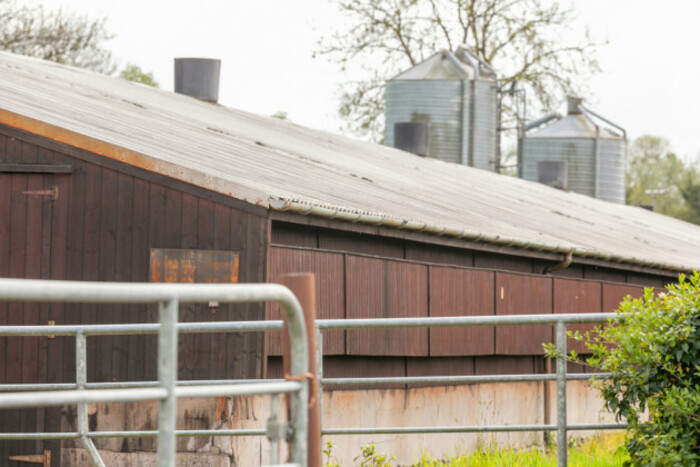 Poultry housing unit in the border area
Poultry housing unit in the border area
Enforcement cases progressing
We also sent FOI and press requests to local authorities in the North. Two councils confirmed that they have opened a number of enforcement cases, while others said that investigations are ongoing.
One authority told us that it was “aware of the issue”, was “seeking legal advice on the matter” and that it “would be inappropriate to comment any further at this stage”.
In a follow-up press statement, it said that “naturally, the Council takes the matter seriously” and that since this issue arose, it now seeks verification from Teagasc “as to the authenticity of the correspondence provided in its name”.
“We can also confirm that we have opened a number of enforcement cases and are investigating cases where an alleged breach of conditions on permissions for intensive animal housing may have occurred, specifically where litter is being disposed of in locations other than those specified by the permission,” it added.
Another council said they would not release details as “the information requested is included in a number of live enforcement cases with the Council’s Planning Department”.
One council said that the records held were “received as part of an investigation into potential criminality”, while a further council said that release of records “would prejudice the investigatory and/or the possible legal proceedings”.
Another refused to release records “on grounds of [an] ongoing criminal investigation”, arguing that release of the information to “the world at large” would place the ongoing investigation “at a significant disadvantage”.
None of the councils have revoked any planning permissions to date, while one said that it was not aware of any planning approvals being granted on the basis of falsified documents.
Other councils said they are now checking letters with Teagasc directly, whereas before this matter arose, one said that they took the letters at “face value”. Another said that, prior to the issue being raised, “as per our normal procedures the Council was not required to seek to verify the legitimacy of such supporting documents”.
Going forward, one council said they “have reviewed procedures to mitigate against potential for future fraud”. DAERA also told us that, “in response to current concerns”, it has also “introduced an enhanced verification process for Teagasc letters received”.
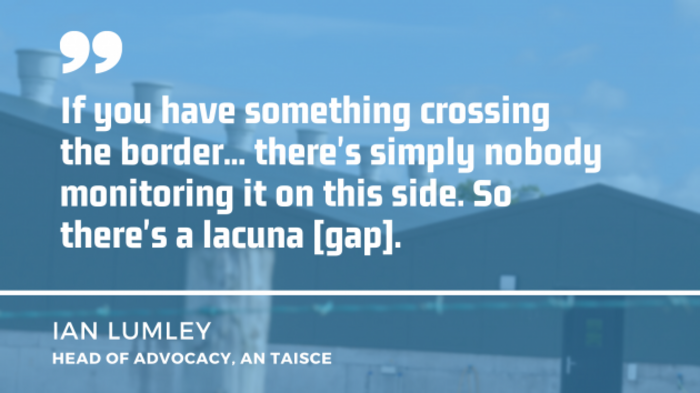
An Taisce raise concerns
Environmental groups in the Republic have also raised questions about the control of litter coming from Northern Ireland, with An Taisce’s Ian Lumley telling us the group has “no confidence whatsoever in the management regime for litter, particularly cross-border”.
An Taisce is a statutory consultee in the planning system and Lumley has made dozens of submissions on intensive farm planning cases. While the system isn’t perfect, he said that plans for manure spreading are clearer in planning applications in the Republic.
“But if you have something crossing the border from Northern Ireland into a local authority area [in the Republic], there’s simply nobody monitoring it on this side. So there’s a lacuna [gap].”
An Taisce outlined its concerns to the Minister for Agriculture Charlie McConalogue in March 2021 calling for an investigation into a “systemic lack of scrutiny by Irish authorities of importation of animal waste”.
It said the “unapproved and unscreened importation of significant quantities of animal waste into this jurisdiction is in direct violation of international and domestic [environmental] law” and pointed to two planning files for poultry farms in which Teagasc letters were included.
In July 2021, the Minister replied that any operator in Northern Ireland who wishes to dispatch manure to this jurisdiction “must complete the appropriate application form prior to dispatch and state the source of the manure, the destination, the means of transport, the quantity and its use”.
A Department vet reviews the application and, “only on receipt of their approval, is authorization to dispatch granted”, he said. “On the basis of the above, DAFM has knowledge of every load of manure, its origin and farm of destination prior to transportation.”
An internal email chain from late May 2021, however, paints a different picture with staff unable to find details of applications for litter transport in the cases raised by An Taisce.
Writing to the individual assigned with searching for the records, one staff member said: “I think it’s safe to say we did not receive any applications for the dispatches from [Northern Ireland] referred to in the [An Taisce] letter.”
FOI requests to both the Department and Teagasc confirm that no details of Teagasc’s investigation were shared with DAFM by the time that the Minister replied to An Taisce.
We asked the Department if it had carried out any further investigation into the cases in An Taisce’s complaint letter. It said that it was “not in a position to provide information where it relates to specific businesses or named individuals or individual cases”.
Our investigative team also sent the full list of planning cases in which we identified litter contracts and asked DAFM to verify if it received applications for litter shipments in each case.
While the Department said that “information contained in the list… has been examined”, it added that, “in carrying out its regulatory role, the Department does not comment or provide any details in respect of any investigation that may or may not be underway”.
Other problems surface in the Republic
An Taisce has also raised concerns about the regulatory system for the domestic litter trade in the Republic of Ireland, particularly from larger farms of 40,000 birds or more under the Environmental Protection Agency’s licensing system.
The Nitrates Regulations require a minimum of 26 weeks of storage capacity for organic fertiliser on poultry farms, yet our analysis of EPA licence records show that most farms only have the capacity to store eight weeks or less worth of manure.
However, the EPA deemed the majority of applicants exempt as they have agreements for the removal of litter. The EPA’s remit in terms of litter transport, however, does not extend beyond the farm gate as licences only relate to the boundary of the farm.
Under the Nitrates Regulations, the licence holder must submit records of movement of litter to the Department of Agriculture annually, with a copy stored at the farm for possible examination during inspections by the EPA, DAFM or local authorities.
Internal records of a meeting between DAFM and the EPA in May 2021 show that there are gaps in the system, however, with “issues with tracking of organic fertiliser and its impacts on water quality” discussed at the meeting.
“It was felt there are holes in the data available,” the minutes state, with the EPA reinforcing to the Department that its “remit does not extend beyond the site boundary of installations”.
Environmental consultant Jack O’Sullivan, who has experience dealing with farm licence cases, told our team that, while on paper, there is a control system in place for the export of manures, he is very concerned about the real world implementation of it.
“The EPA will consider all of the activities within the red line boundary of the site but anything outside that boundary is a matter for the farmers themselves to take care of the organic fertiliser,” he said.
“Once those lorry loads of poultry litter go outside the gate, there’s no control. The Department of Agriculture should exercise some control [but] they really don’t,” he said, while councils don’t have the manpower or resources to do so either.
Concerns at local authority level
O’Sullivan’s concerns are also reflected by local authorities themselves, according to records released from Monaghan County Council that oversees the largest concentration of farms in the country.
A detailed 2021 report on the poultry industry, commissioned by the council, estimates that 250,000 tonnes of litter is produced annually, with concerns raised over monitoring, regulation and enforcement with respect to the control of litter landspreading.
The report points to a “lack of a robust cross-agency data and information sharing system”, including the continued use of paper forms limiting local authorities ability to monitor manure movement and usage.
Records released to our team reveal these concerns were raised at a meeting between the Council’s environmental team and Fehily Timoney – the consultancy that produced the report. The council outlined the challenge of “how to manage controls of where manure goes”.
A May 2021 email from Kieran Duffy, the environmental team’s executive engineer, provides clarity on internal concerns over control of where litter from farms ends up.
Providing comments on a draft of the report, he took issue with a line that said there were “strict regulations” to mitigate impacts from landspreading. Writing in bold red, he commented that “the ‘strict regulations’ referred to above are not working adequately”.
“In reality,” he said, “there are significant deficiencies nationally in respect of the control systems in place in relation to the management and tracking of organic fertiliser from source to end user”.
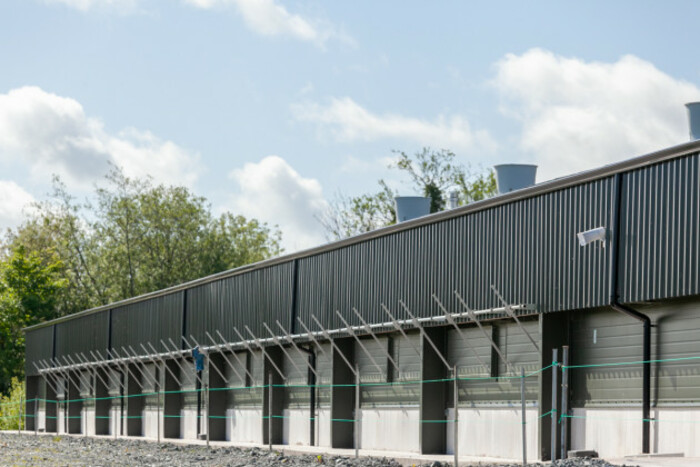 Poultry farm shed in the border region
Poultry farm shed in the border region
Problems raised as early as 2019
The Council’s concerns date back to at least July 2019 in a Monaghan County Council report to the Local Authority Waters Programme (LAWPRO) – an agency examining water quality issues in each county.
The report – released to our team – states that conditions at the planning stage to ensure litter is exported to tillage land or composting facilities “are currently not checked nor is there an enforcement inspection regime in place due to lack of resources”.
We asked authorities in Monaghan and Cavan for inspection rates of poultry farms between 2017 and 2021. Cavan carried out just two inspections, while Monaghan carried out 95 inspections between 2016 and 2019, but only inspected five farms since 2019.
Cavan said its inspection rate is linked to complaints received. Monaghan said that a non-statutory inspection program ran from 2016 to 2019, “hence the reason for the reduction in specific poultry farm inspections”.
When asked if its current inspection rate is enough to ensure planning conditions on litter exports are met, the council said that it did not have other comments to make on this matter.
LAWPRO also released a 2019 submission from Cavan and Monaghan representatives in which serious concerns were outlined about “lack of information and transparency on manure movements”.
The report raised concern about responsibility put on councils for enforcement and tracking litter once it leaves EPA-licensed farms. “This is a large workload given the high number of licensed premises we have,” the report states.
The report also found litter export forms were “not completed by a large portion of poultry farmers,” with half of 110 farms surveyed in 2017 and 2018 not returning forms to DAFM.
Water authority has concerns
LAWPRO has raised its own concerns with DAFM and the EPA for several years about the regulatory system for the movement and spreading of poultry litter.
In December 2019, it produced a report on the regulatory controls for large poultry units. It outlined that, in terms of litter shipments, “receiving counties receive no advance information on incoming manures, landbank destination or landbank selection criteria”.
In terms of the landspreading itself, the document states that “information is not readily available for a detailed investigation” if a pollution complaint arises and that there is no mechanism in place to ensure society that complaints can be dealt with satisfactorily.
Concerns were raised with the EPA in February 2020, according to a LAWPRO memo released to us, with the issues also “raised previously with both [the] EPA and DAFM with no resolution that satisfies [local authorities] concerns”.
DAFM told us it engages with LAWPRO and other stakeholders on an ongoing basis, and introduced an on-line system to register litter movements in 2021. The EPA said it received the LAWPRO report, and that it “takes landspreading and transporting into consideration” as part of the licensing process.
Where do we go from here?
While investigations are ongoing in the North, there are robust agri-expansion policies in place on both sides of the border to continue the expansion of the industry, which will mean more poultry sheds, more birds and more litter produced.
According to environmental scientist Jack O’Sullivan, if the industry is to expand even further, there is a clear need for greater cross-border coordination to ensure a robust poultry litter system with control of where the litter is going and when it is being spread.
“There’s clearly a problem of who should be doing what, and that, in turn, demands monitoring because without knowing what the problem is, how can we then put the correct and appropriate control systems in place?”
*Name changed to protect identity
—
Our colleagues on the investigation team at The Detail also published an article today which delves more deeply into issues in Northern Ireland which you can read now.
Our other project partners The Guardian also published an article examining concerns from environmental campaigners that the Republic of Ireland is becoming a “toilet” for cross-border pollution. You can read the article here.

This investigation was written by Niall Sargent of Noteworthy. It was proposed and co-funded by you, our readers. This article was developed with the support of Journalismfund.eu as part of a cross-border project with Rory Winters, Luke Butterly and Tommy Greene for The Detail and Ella McSweeney for The Guardian.
Noteworthy is the investigative journalism platform from The Journal. You can support our work by helping to fund one of our other investigation proposals or submitting an idea for a story. Click here to find out more >>
We also have a number of farming, climate and biodiversity-themed investigation proposals which you can view here.



